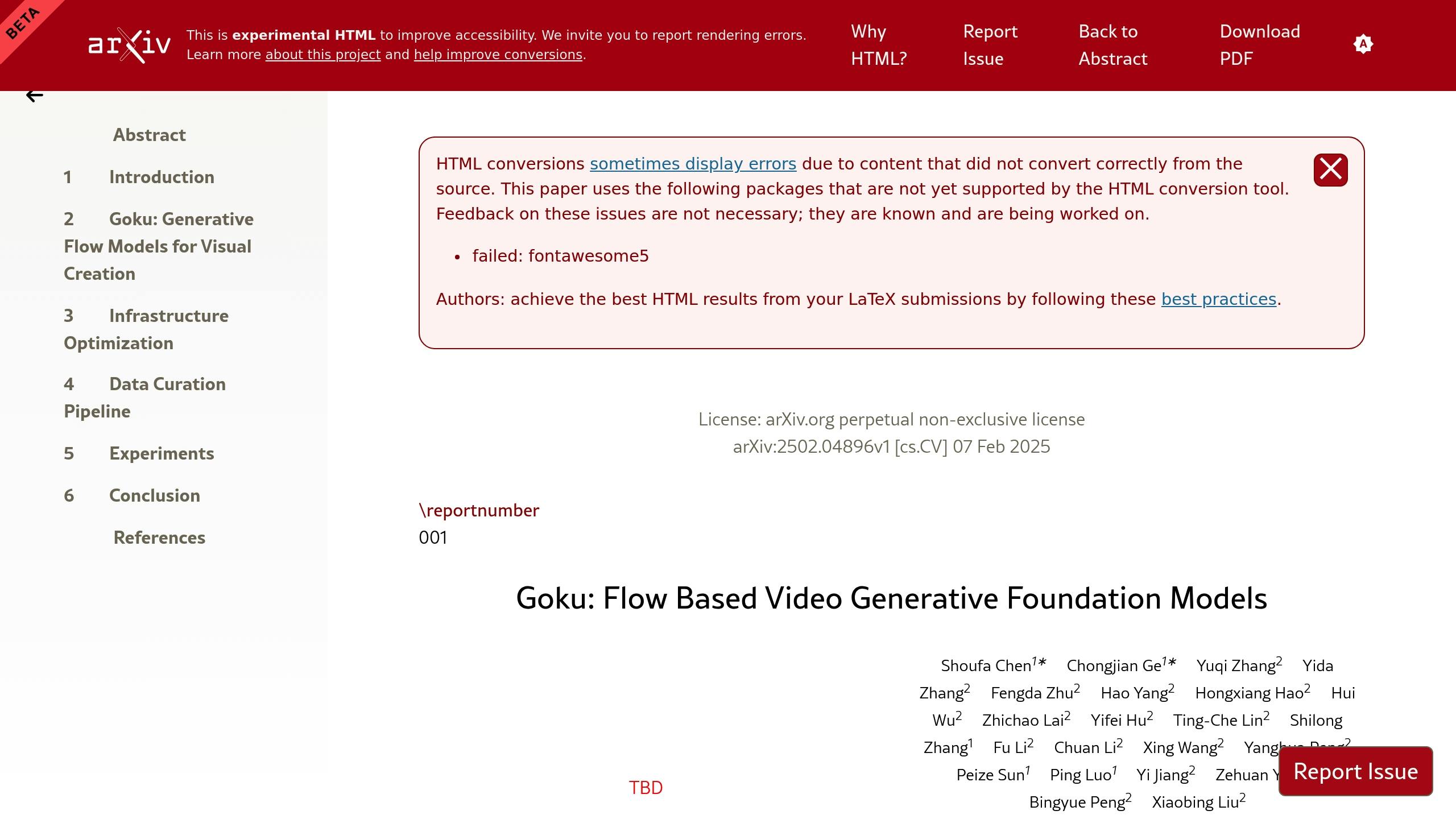ByteDance‘s Goku model is reshaping AI-driven content creation. It uses flow-based models for generating high-quality images and videos with precision and stability. Goku supports tasks like text-to-video, image-to-video, and text-to-image creation, trained on vast datasets and designed for industries like media, gaming, and e-commerce.
Key Highlights:
- Core Features: Text-to-video, image-to-video, text-to-image generation.
- Technical Strengths: Flow-based architecture ensures sharper visuals, stable training, and efficient resource use.
- Performance Metrics: Scores 0.76 on GenEval and 83.65 on DPG-Bench for text-to-image tasks.
- Applications:
- Media: Automate video production with over 1,000 variations per product.
- Gaming: Simplify asset creation and animations with text prompts.
- E-commerce: Generate interactive product demos and virtual try-ons.
Quick Comparison of Models:
| Feature | Goku (Flow-Based) | GANs | VAEs |
|---|---|---|---|
| Training Stability | High | Medium | High |
| Video Quality (VBench) | 84.85 | ~75-80 | ~70-75 |
| Temporal Consistency | 97.71 | Flickering | Blurring |
| Edit Control | Precise | Limited | Moderate |
Goku is optimized for speed and efficiency, completing training 60% faster than traditional methods. It runs on advanced GPU clusters but requires robust hardware to maintain performance. ByteDance ensures safety with content filtering, watermarking, and regional compliance, though minor limitations like resolution drops remain.
Stay tuned for Goku’s upcoming API access and enhanced features in 2025.
How Goku‘s Flow-Based AI Works

Flow-Based Model Mechanics
Goku’s architecture is built on ByteDance’s focus on stable training, utilizing reversible data transformations to maintain information accuracy. This is achieved through rectified flow technology, which cuts required training steps by 60% [1][4]. By using linear interpolation between noise (ε) and data (x), Goku achieves faster convergence – completing training in just 400K steps compared to the usual 1M for ImageNet [4]. This streamlined approach forms the backbone of Goku’s advanced features.
Goku’s Technical Features
ByteDance has equipped Goku with several standout technical elements:
- A unified 3D VAE encoder and transformer backbone processes images and videos as spatial-temporal tokens, allowing efficient synthesis at 720p/24FPS using ByteCheckpoint [3][4][6].
- To optimize resource usage, Goku runs on a custom large-scale GPU cluster system. This setup distributes tasks across 512 GPUs, achieving an impressive 78% Model FLOPs Utilization [4].
Model Comparison Guide
Here’s how Goku stacks up against other approaches:
| Feature | Flow-Based (Goku) | GANs | VAEs |
|---|---|---|---|
| Training Stability | High with exact likelihood [1] | Medium with adversarial training [2] | High [2] |
| Video Quality (VBench) | 84.85 [6] | ~75-80 [6] | ~70-75 [2] |
| Temporal Consistency | Frame consistency score 97.71 [3] | Frequent flickering [6] | Blurring issues [2] |
| Edit Control | Precise latent manipulation [4] | Limited [1] | Moderate [2] |
Goku’s edge lies in its ability to model motion effectively and its unified handling of both images and videos. These strengths make it a standout choice for the applications we’ll dive into next.
Goku: Flow Based Video Generative Foundation Models
sbb-itb-5392f3d
Main Uses of Goku
Goku offers practical applications across several industries, leveraging its advanced AI capabilities to streamline workflows and enhance creative processes.
Media Production Tools
ByteDance’s Goku has transformed video production with its AI-driven features. For instance, beauty brands can generate makeup demo videos simply by entering text prompts, while manufacturers automate the creation of device functionality videos [7]. Thanks to its flow-based bidirectional control, marketers can fine-tune video outputs with precision. This allows marketing teams to produce over 1,000 video variations per product, making A/B testing campaigns far more efficient [3].
Game Development Features
Game developers benefit from Goku’s ability to unify asset creation and animation processes. Its image-video generation capabilities simplify tasks that often slow down production.
Here’s how Goku addresses common challenges in game development:
| Development Task | Goku’s Solution | Impact |
|---|---|---|
| Character Animation | Generates sprites and animations together | Cuts animation pipeline time by 60% [4] |
| Asset Creation | Creates assets from text descriptions | Speeds up asset iteration by 40% [5] |
| VFX Production | Produces particle effects and animations | Streamlines visual effects workflows [5] |
The transformer-based system even allows developers to create complex animations using natural language. For example, they can design medieval character movements paired with unique special effects [6][5].
Online Retail Solutions
E-commerce platforms are using Goku to improve product visualization and engage customers more effectively. Its reversible transformations enable retailers to tweak product visuals without losing detail.
Some key applications include:
- Interactive Product Demos: Create dynamic videos showcasing product features and functionalities.
- Virtual Try-Ons: Fashion and cosmetics brands use Goku to generate realistic application videos.
- Technical Walkthroughs: Manufacturers produce detailed videos highlighting product components.
Limits and Safety Measures
While Goku’s capabilities are impressive, deploying it effectively requires understanding its technical constraints and safety protocols.
System Requirements
| Component | Requirement | Performance Impact |
|---|---|---|
| GPU Memory | 80GB VRAM | Reduces frame inconsistencies |
| Network | 400Gb/s | Supports distributed training |
| Storage I/O | >10GB/s | Influences processing speed |
| Inter-node Latency | <2ms | Essential for cluster performance [5] |
With proper hardware setup, clusters can achieve up to 98% efficiency [5]. However, using suboptimal equipment can drastically affect performance. For instance, CPU-only setups suffer from processing times exceeding 5 minutes per frame [4].
Safety and Prevention
ByteDance has integrated several protective measures into Goku to ensure responsible use, reflecting their AI design philosophy:
| Safety Feature | Implementation |
|---|---|
| Content Filtering | Screens input and output |
| Watermarking | Embeds unique signatures |
| Access Control | Ensures vetted partnerships |
| Regional Compliance | Filters based on IP |
The model also includes defenses against adversarial attacks. During tests, prompt injection attacks had a 12% success rate, prompting ByteDance to enhance security with techniques like gradient clipping and adversarial training cycles [4][2].
Some current limitations include:
- Resolution drops to 480p in less-than-ideal conditions.
- Frame inconsistencies that may occur occasionally.
These challenges highlight ByteDance’s effort to balance Goku’s capabilities with responsible and secure deployment practices.
Conclusion: Next Steps for Goku
Main Points Review
ByteDance’s Goku has set a high bar for video quality through its unified image-video architecture. It has shown measurable results across industries, with e-commerce implementations reporting a 200% increase in CTR for AI-generated product showcases [3].
These achievements highlight Goku’s growing influence in practical applications across various sectors.
Future Development
ByteDance is focusing on expanding Goku’s capabilities in media and retail, with clear goals on its roadmap:
| Development Focus | Current State | 2025 Target |
|---|---|---|
| Hardware Requirements | 256+ nodes | <8 GPUs [5] |
To make enterprise adoption easier, ByteDance is working on:
- Transitioning quantization methods from FP16 to INT8 for better efficiency [4]
- Launching API access by Q3 2025 [5]
Emerging prototypes like Goku-Animation, with 97% motion consistency [7], and natural language video editing tools are paving the way for broader creative uses. The integration of transformer models allows for language-guided video editing, positioning Goku as a key tool in AI-driven content creation pipelines.

